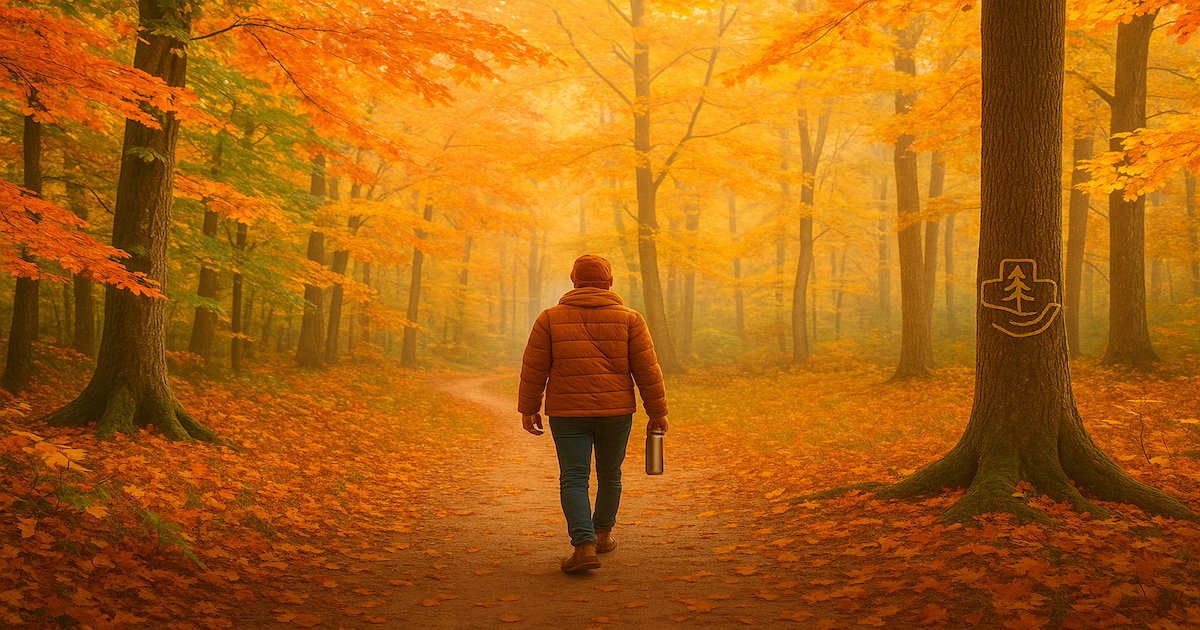Autumn is the perfect season for a Forest Therapy Retreat, offering rich colors, crisp air, and a deeper connection to nature. It’s a time to slow down, ground yourself, and engage all your senses in the changing forest landscape.
Why Fall Foliage Deepens the Sensory Experience
Autumn offers a profound sensory richness that makes it the perfect season for forest therapy.
As chlorophyll retreats, trees reveal vibrant carotenoids and anthocyanins, painting the woods in fiery reds, warm golds, and sunset oranges .
These changing colors aren’t just visually stunning, they also slow us down.
In the crisp air, the rustle of falling leaves, the scent of decaying foliage, and the golden-angle light amplify our awareness.
Autumn invites us to go inward while going outside, a paradox that deepens connection to nature and self.
Contents
1. Choosing the Ideal Woodland Location: Maple, Aspen, Oak
Where you walk matters. In autumn, maples, aspens, and oaks offer some of the most striking color displays:
- 🍁 Sugar Maples (Acer saccharum): Known for their brilliant reds and oranges. Look for forests dominated by these in northeastern U.S. or southern Canada .
- 🍂 Quaking Aspen (Populus tremuloides): Their golden yellow leaves shimmer and rustle uniquely in the wind—a perfect audible invitation .
- 🌰 Red and White Oaks (Quercus spp.): Offering a broad range of late-fall colors, from deep crimson to russet browns. These trees tend to hold leaves longer, extending the season .
Seek out trails with mixed hardwoods to maximize your visual palette and seasonal transitions.
2. Seasonal Invitations: Leaf-Listening, Bark-Touch, and Scent Pauses
Fall rituals help participants connect with nature’s slow exhale:
- Leaf-listening: Pause beneath trees to hear the quiet cascade of leaves. Ask: What emotions arise when you hear the letting go?
- Bark-touch meditation: With leaves fallen, trunks and textures become more prominent. Invite tactile awareness—feel the fissured bark of an oak, the smooth gray of beech.
- Scent pause: Autumn’s earthy decay is an olfactory grounding. Pause, inhale, and note: Can you detect the spice of fallen pine needles? The dampness of turned soil?
These micro-practices re-engage sensory systems that often dull in colder weather.
3. Adapting Your Ritual Toolkit for Cooler Temps
As the temperature dips, modify your kit to support longer, more comfortable sessions:
- 🧣 Bring layers: Opt for moisture-wicking innerwear, a warm mid-layer, and windproof outer shells.
- 🔥 Thermal sitting gear: Use insulated sit pads or lightweight foam mats to avoid cold transfer during seated invitations.
- ☕ Warm beverages: Herbal teas (like ginger or cinnamon) can offer internal warmth and an extra sensory experience.
- 📿 Seasonal props: Incorporate acorns, colored leaves, or pinecones into closing rituals or mindfulness crafts.
4. Safety & Comfort—Layering, Hydration, Trail Awareness
While autumn’s coolness is invigorating, it comes with its own safety checklist:
- 🥾 Footwear: Trails may be slippery from wet leaves—wear high-traction hiking boots.
- 💧 Hydration: Cooler weather can mask thirst. Carry insulated bottles to keep water from freezing.
- 🧭 Trail visibility: Earlier sunsets mean shorter light windows. Always carry a headlamp and let someone know your route.
- 🧥 Layer smartly: Avoid cotton; it traps moisture. Aim for breathable but insulating gear.
Autumn isn’t just a backdrop, it’s an active participant in your forest therapy practice.
It mirrors transition, release, and the beauty of impermanence. Whether you’re guiding clients or going solo, adapting your practice to this season can offer some of the most memorable, grounded sessions of the year.


1 thought on “The Ultimate Autumn Forest Therapy Retreat”
Comments are closed.